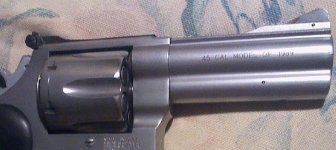Southern Shooter
New member
Is something wrong here?
I thought all revolvers which shared sister calibers but are "weaker" rounds like .38 Special, .44 Special, .45 Colt had cylinder chambers cut so the more powerful rounds like .357 Magnum, .44 Magnum, .454 Casull could not be loaded into them.
I have a 1989 production S&W 625-3 in .45 Colt that allows .454 Casull to fit in its chambers. NOTE: I have NO intentions of firing .454 Casull rounds in this gun !! I just happen to notice that the portion of the chamber allowing a brass to be inserted only so far is NOT there. The chambers just gradually taper as they reach the portion nearest the forcing cone.
Is this the way the gun was designed?
Thanks
I thought all revolvers which shared sister calibers but are "weaker" rounds like .38 Special, .44 Special, .45 Colt had cylinder chambers cut so the more powerful rounds like .357 Magnum, .44 Magnum, .454 Casull could not be loaded into them.
I have a 1989 production S&W 625-3 in .45 Colt that allows .454 Casull to fit in its chambers. NOTE: I have NO intentions of firing .454 Casull rounds in this gun !! I just happen to notice that the portion of the chamber allowing a brass to be inserted only so far is NOT there. The chambers just gradually taper as they reach the portion nearest the forcing cone.
Is this the way the gun was designed?
Thanks
Last edited:

